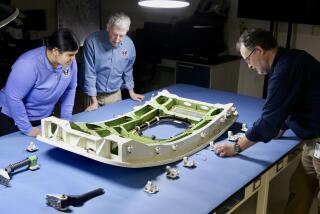Reports Detail History of Non-Injury Failures
- Share via
Two Airworthiness Directives requiring inspection and repairs of the horizontal stabilizer trim system on DC-9/MD-80 aircraft models have been issued by the Federal Aviation Administration during the last four years, an inspection of records reveals.
Additionally, a number of failures of the system on specific aircraft have been reported by airlines to the FAA. None apparently caused an accident, however, although some forced planes to make emergency returns to departure airports.
The most recent Airworthiness Directive--an FAA order that forces aircraft manufacturers and operators to take action--was issued May 6, 1999. It calls for a one-time inspection to detect corrosion in the hinge mechanism where the horizontal stabilizer attaches near the top of the vertical stabilizer. It resulted from apparent “improper brushing of cadmium on the hinge plates during manufacture.” Airlines were given 18 months to complete inspection of about 706 planes affected, at an estimated cost of $7,020 per plane. The additional cost of replacing the hinge plates where corrosion was found was not estimated.
On March 4, 1996, the FAA issued a new directive superseding a previous order requiring inspection and replacement of incorrectly manufactured primary trim motors. The problem motors were first identified in 1994. The motor shafts could fail prematurely, causing the motor to fail. The motors’ manufacturer, Sundstrand Electric Power Systems, was required to provide the repair parts at no cost, but the airlines had to bear the labor costs of inspection and replacement, estimated at $240 to $3,600 per plane. The work was to be completed within six months.
It was not immediately clear from publicly available FAA records whether the Alaska Airlines MD-83 that crashed had the required work completed.
It was possible, however, to find a variety of horizontal stabilizer problems reported on various models of the DC-9/MD-80 family of aircraft, although none for N963AS--the plane that crashed Monday.
In 1993, a USAir DC-9 had to return after takeoff when pilots were unable to trim the nose of the aircraft down. The effect, if not compensated for by the pilot operating the yoke, would leave the plane in a perpetual climbing attitude and eventually could have caused it to lose flying speed and stall. The primary trim motor and a relay switch were replaced, fixing the problem.
In another 1993 incident on Target Airways, a trim actuator was replaced and the new unit was found to operate backward. It was replaced.
In 1994, the primary trim failed on a Northwest Airlines craft after takeoff, which was later traced to a faulty circuit breaker.
Also in 1994, the primary and secondary trim systems failed after takeoff on another Northwest plane, but later the secondary system worked. The primary trim stabilizer motor was replaced.
Again in 1994 on a Continental Airlines flight, the primary trim system failed on takeoff, but the plane continued to its destination, where the primary trim motor and its wiring were found to be burned.
Another Northwest flight in 1994 experienced an “uncommanded nose down pitch change” after takeoff, which the pilots overrode with manual trim handles. After they returned to the departure airport, a failure was found in the first officer’s control wheel trim switch.
In 1997, the alternate trim system on a Spirit Airlines aircraft experienced a “runaway” after a landing. The alternate trim switch was replaced.
Another case of burned trim motor wiring and a defective motor was reported on a Continental plane in 1998, after the aircraft returned to the departure airport when the primary trim system stopped operating. New wires were spliced into place and the motor was replaced. The plane returned without incident after the failure occurred.
Also in 1998, a primary horizontal stabilizer failure on a Hawaiian Airlines plane was traced to broken springs in the elevator system, which is at the rear of the stabilizer.
Corroded jack screw threads were blamed for another horizontal stabilizer trim failure in 1998 on an ABX Air Inc. aircraft. The jack screw and nut were replaced.
Last year, a report of failure of the primary trim system on a Hawaiian Airlines flight was made, but no cause or repair was indicated.
More to Read
Inside the business of entertainment
The Wide Shot brings you news, analysis and insights on everything from streaming wars to production — and what it all means for the future.
You may occasionally receive promotional content from the Los Angeles Times.










